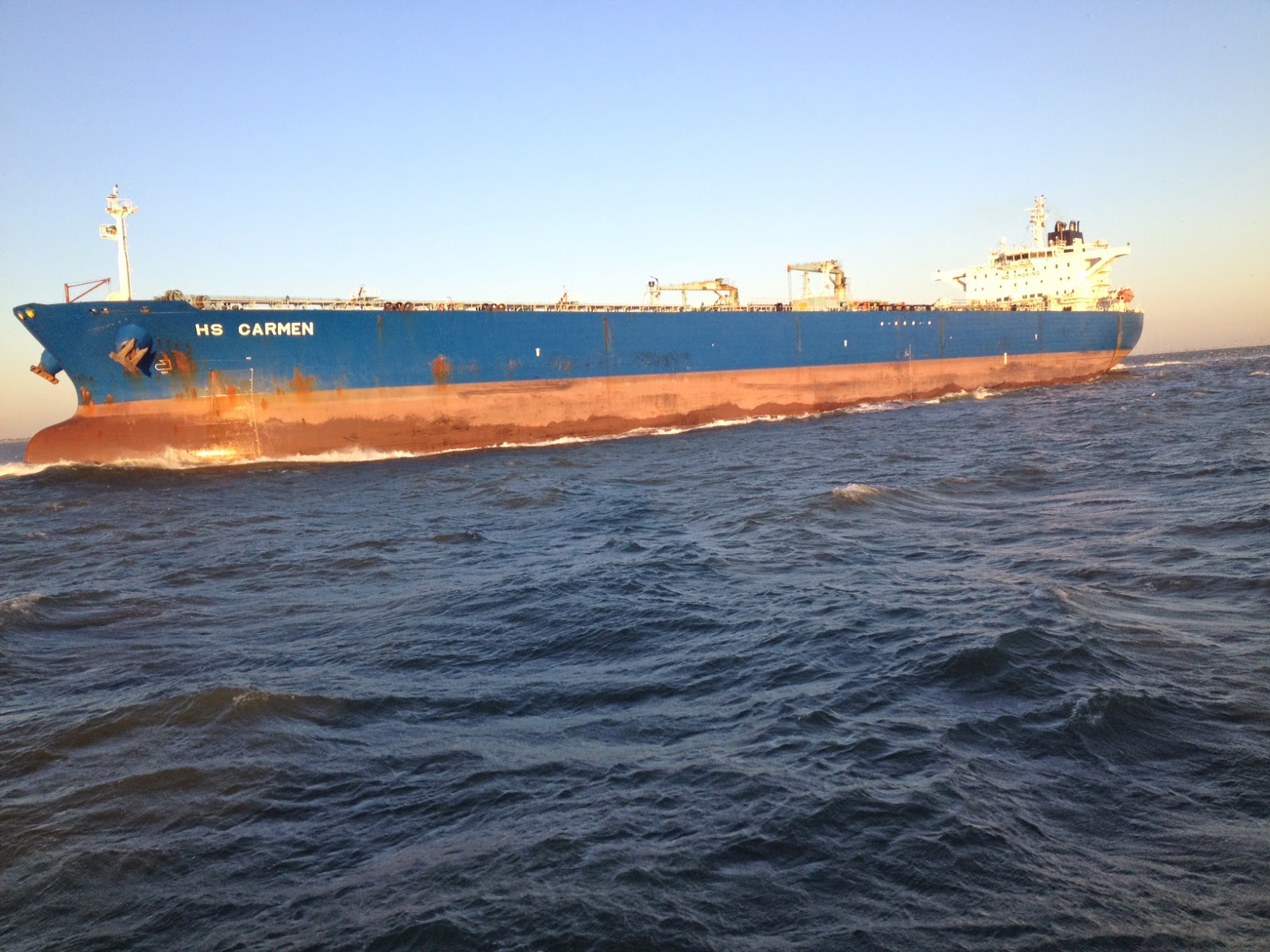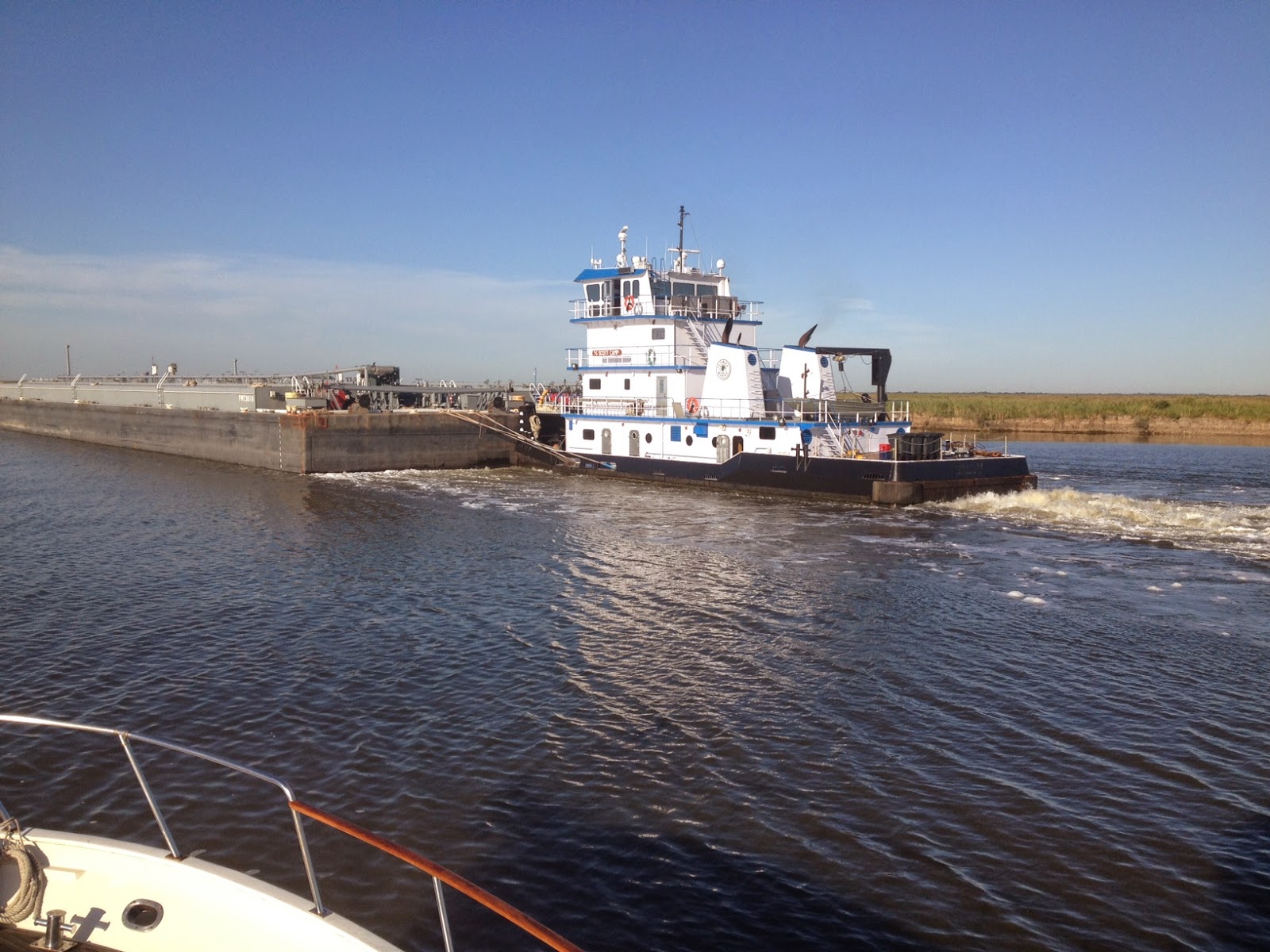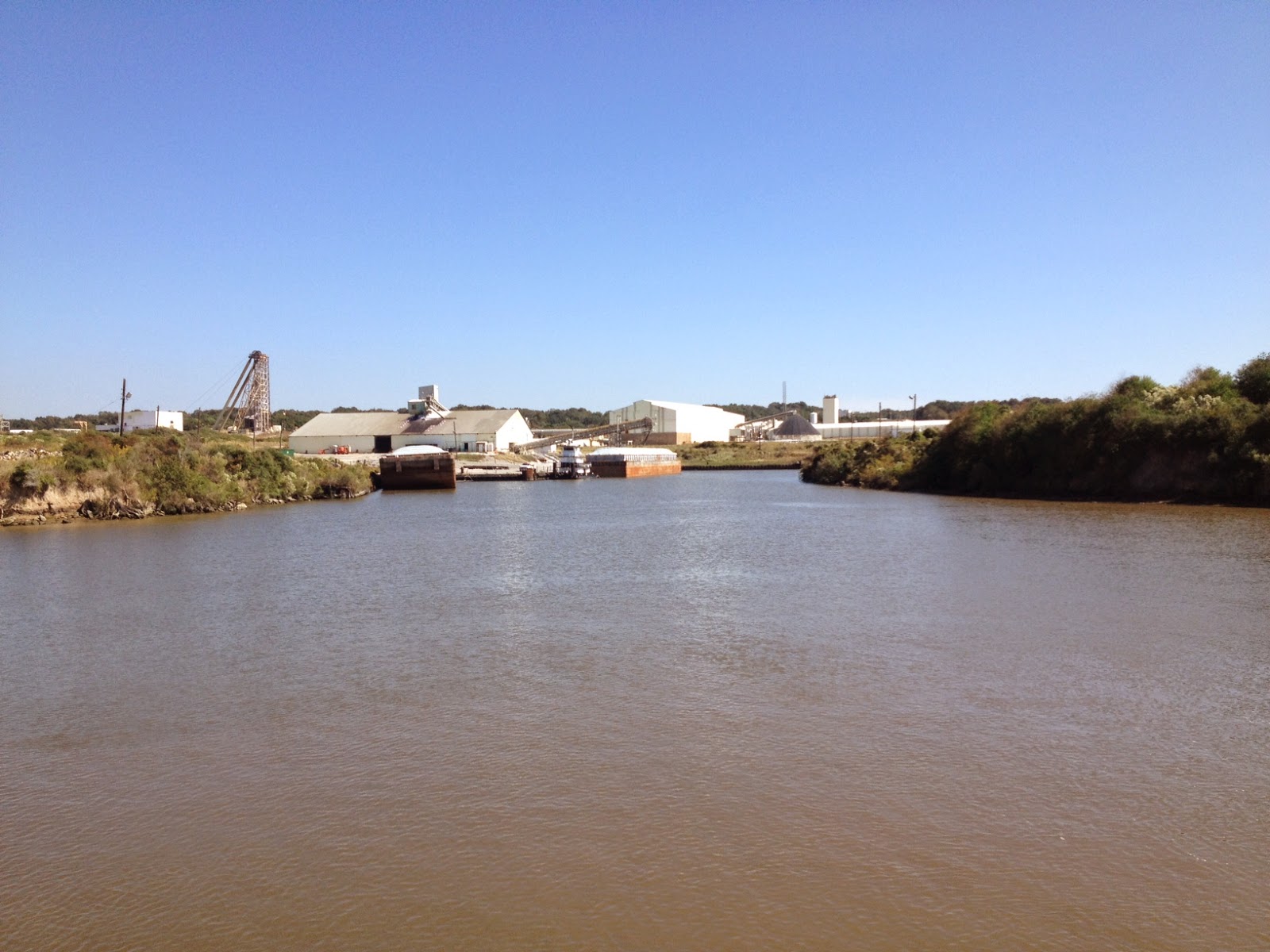"Honey, I think that we should get started about 5:30 am tomorrow." Trust me that these are scary words, but tomorrow is a difficult day as far as scheduling goes. We have a bridge closed from 3-5:00 pm and a lock closure for construction from 7:00 am to 5:00 pm to deal with in a day where we hope to travel 91.9 miles. It is an ambitious schedule, but we had several "back up" anchorages in case the "best case" scenario did not work. The worst case scenario was that we would be delayed and anchor out. The best case scenario was that we would be playing slot machines at L'Auberge Casino and Resort in Lake Charles. Somehow we both managed to sleep well in spite of thoughts of juggling schedules to adjust for possible or real delays....
We departed the fuel dock/marina at Intracoastal City at 5:30 am. This was an hour or so before sunrise, and you can consider yourself lucky that I did not insert a blank/black slide to show the sky... We had a short 3.4 mile trip to the Leland Bowman Lock. There was some light most of the way from several businesses along the waterway, but there was also a (very low) patchy fog. On the flybridge we were basically above the fog and could see the banks of the waterway through the darkness. Well, going slowly with aid of the chartplotter, AIS and radar, we felt safe. We arrived at the lock, which is a lock designed to prevent salt water intrusion into coastal (fresh water) marsh lands. As we arrived, the gate opened, and we crept forward slowly as the gate closed behind us. Then, almost immediately, the gate in front of us opened. Thus, we never really stopped moving nor did we have to tie up. So, we cleared the lock at 6:09 am, and at that point we were still good to go for our most optimistic day.

At that point we had 68.1 miles to go in 9 hours to get to a pontoon bridge before it closed at 3:00 pm for 2 hours. However, it was still dark with some scattered fog so progress remained slow. By about 7:30 am the fog had mostly burned off, and we were able to go at our normal cruising speed. A quick calculation showed that if we had no prolonged adverse tidal currents that we should reach the pontoon bridge about 2:30 pm.
It was about at this point that we learned another new towboat term. The picture at the right shows at towboat with a hydraulic helm station that goes up/down depending upon the height of the barge. We have seen plenty of these, but we had never heard them referred to as a "jack up" towboat. I hope that this little tidbit of knowledge totally makes your day (ha, ha).
At this point, the Admiral took the controls so that I could take a nap. It had been a busy and somewhat tense trip so far, but I managed a nice 1.5 hours of sleep. We managed to keep our average speed at just over 8 mph in spite of some adverse as well as friendly currents.
We did not have a lot of time to take pictures today since we were pretty busy. However, I did get another photo of a "spool" on a barge. ha ah.
Along the Gulf Coast, the tows "chat" on VHF channel 13, and you talk with locks and bridges on channel 14. Everyone is also required by law to monitor channel 16, which is the official distress channel. It is easy to set the VHF to scan all three channels, but then you hear almost constant chatter on the radio. Trust me that I have more than once considered just shutting it all off for some peace and quiet, but...
We reached the Grand Lake Bridge at about 2:30 pm and passed through with no delay. It was one of the classic bridges which is really a barge that is hinged on one corner. Cables pull the bridge open and closed. It is a fascinating operation to watch. There used to be quite a few of these in Texas, but more of them are replaced by high, fixed bridges every year. No doubt the local residents appreciate not having the (5 or 10 minute) delays, and I am sure that there is a certain safety factor in the case of emergencies. However, for the sake of progress, we are losing a bit of history ever time that one of these is replaced.
Now, after clearing the pontoon bridge, the last real obstacle is the lock closure. We arrived at the Calcaseau Lock at about 3:00 pm, which was two hours before the lock was supposed to open. We had been passing a few east bound tows, but we did not think too much about it. Tows often pull into the bank for rest periods, etc. However, when we arrived at the lock, there was no line. There was one west bound tow in the lock ahead of us. However, we were "next" in line. It turns out that the repairs involved replacing "bumper boards" on the approach wall into the lock. Tows are often blown about as they attempt to ease into the lock. The lock walls outside on the approach are designed to funnel the tow into the lock. Evidently, the boards are designed to be somewhat sacrificial, which means that after enough of them get broken, they must be replaced. Today, the workmen on our approach side were working on the top two rows, and they were standing on top of the walls to do this. For boards lower down, they need to work from a barge, and the barge blocks the lock entrance. So, "Lucky Us" as the boat name implies. We were able to transit the lock without even tying up.

The picture at the right shows the tows that were lined up at the other side of the lock. This is more like what we had been expecting when we had arrived at the other (east) side of the lock.
So we thanked our lucky stars and proceeded on for 12 miles to Lake Charles, LA.
Lake Charles is another very busy oil port on the Gulf Coast. The picture at the left shows one of several tankers that we passed on the way to Lake Charles.
There are also several refineries that we go past, and there are more just up river and closer to the city of Lake Charles.
When we stayed in Lake Charles on our way east to start the Loop, there was a lot of construction going on next door to the L'Auberge Casino where we have always stayed when in Lake Charles. In the photo at the right there are now two casinos at this location. The L'Auberge is the one just left of center, and it appears smaller since it is a little further away. The closer one, which appears larger, is the new Golden Nugget Casino and Hotel. The new Golden Nugget looks like it is very close to being finished. However, from what we could see there is no marina (yet?).
We were the only boat in the marina so we had our choice of docks. After checking into the hotel (or marina), we had a very nice dinner at the Jack Daniel's Restaurant. What a day! We had a lovely dinner and were back on the boat before 8:00 pm. In our worst case scenario, we would probably not have arrived at the marina before 8:30 pm at the earliest (or at an anchorage). We are going to stay here for at least two nights so tomorrow I will be sleeping in....























































